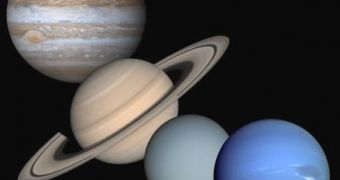Just before 2006, Pluto was still considered the most remote planet in the solar system. However, due to the discovery of a series of objects that had similar sizes and characteristics to that of Pluto, the object has been demoted from its status of planet to that of Kuiper belt object, or minor planet. Currently, the solar system consists of eight planets, four inner rocky planets and four gas giants.
Jupiter is the closest gas giant to Earth, and the biggest of the planets in the solar system. With a estimated diameter of about eleven times that of our planet, Jupiter packs about twice the mass of all the other seven planets. Saturn, the sixth planet from the Sun is a little smaller than Jupiter, and unlike the other planets it presents a special feature. Around its equator orbits a thin ring of matter consisting of dust and ice particles. Uranus and Neptune have diameters about four times that of the Earth.
Unlike the rocky planets, all these four gas giants differ widely in structure, meaning they are mostly formed of gases such as helium and hydrogen. Jupiter and Saturn were known to humans since early times, as they appear on the night sky as bright stars easily visible with the naked eye. Jupiter will routinely outshine all the other planets, except for Venus, on its way around the Sun. Uranus and Neptune , however, cannot be observed with the naked eye, and require optical instruments such as telescopes. Uranus was discovered in 1781 by William Herschel, while Neptune, in 1846 by Johann Galle.
NASA's Voyager 1 and 2 missions had huge success in studying the planets in the outer regions of the solar system, and currently we know as much about the gas giants, as all the other rocky planets in the inner solar system.
Jupiter has an average distance from the Sun of about 778 million kilometers, and requires about 12 year just to make a complete rotation around it. Its diameter measures 142,600 kilometers and the planet is easily visible from the surface of the Earth with the help of a telescope. It has one of the fastest spin rates compared to the other planets, completing a rotation around its axis in about 10 hours. Its wild weather is dominated by the presence of a large cyclon near its equator with a diameter larger than that of the Earth!
The great red spot as it is called could have been visible from the surface of the Earth for centuries. It is mostly believed that beneath the heavy atmosphere of the planet lies an ocean of hydrogen gas in a highly compressed state. In fact, if the planet would have been only 10 times its current size, it had turned into a star. Though only about sixteen satellites of the planet are relatively well known, the fact is that Jupiter has more than sixty other smaller objects orbiting around it.
Saturn is the second largest planet in the solar system after Jupiter, with a diameter of about 120,000 kilometers and an orbit twice as large of Jupiter's, requiring no less than 30 years to make a complete rotation around the Sun. Calculations reveal that winds in Saturn's atmosphere may exceed 1,800 kilometers per hour. Its distinct rings orbiting it have a diameter about twice of that of the planet and are divided into at least three distinctive rings separated by clear lanes. The Cassini-Huygens spacecraft revealed that the rings might be as thin as 20 kilometers. Saturn has at least 23 natural satellites.
Uranus is the third largest planet in the solar system. With a diameter of about 51,800 kilometers and a distance to the Sun twice as large as Saturn's, Uranus completes a rotation around the Sun in about 84 years. On top of that, the planet presents a unusual tilt in relation to the planet's eccentricity, which might have been caused by a massive collision with another planet.
Its distinctive blueish-green color is given by the presence of high concentrations of hydrogen and helium gas, on top of gaseous layer of boiling ammonia. Similar to Saturn, the planet has a thin ring of dust orbiting around it and about 10 known natural satellites.
Last but no the least, Neptune is relatively similar to Uranus in size, having a diameter smaller by only 2,000 kilometers. It is situated at about 500 million kilometers away from the Sun, and completes a rotation around the previous in 165 years. It has a blueish appearance with two bright rings around the equator. Except its two big natural satellites, Nereida and Triton, Neptune has an additional six objects orbiting around it.

 14 DAY TRIAL //
14 DAY TRIAL //